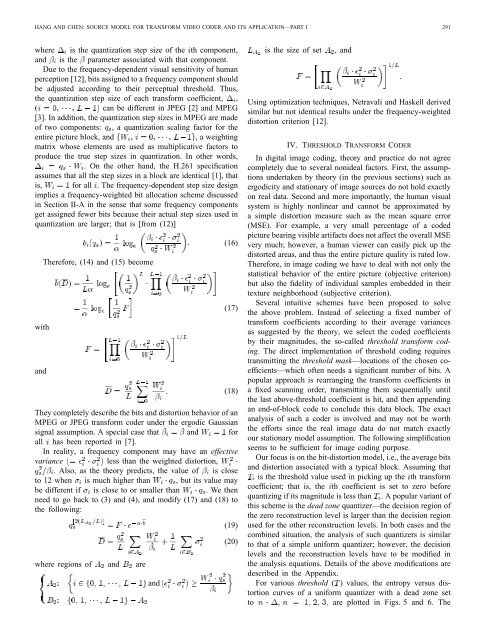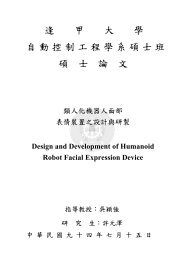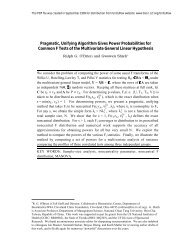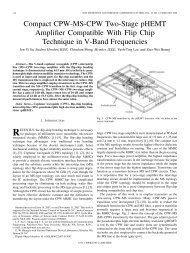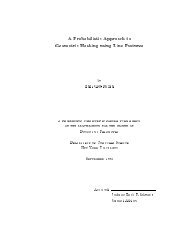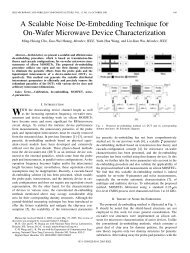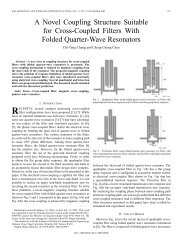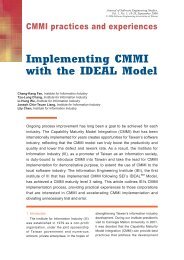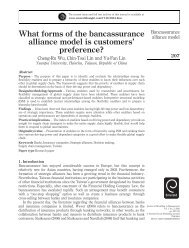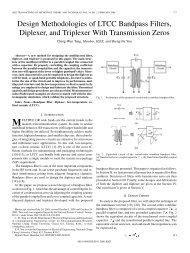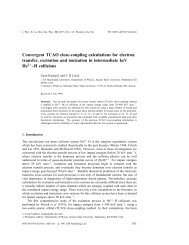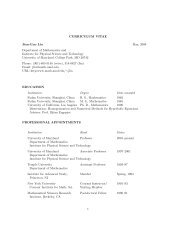Source Model for Transform Video Coder and its ... - ResearchGate
Source Model for Transform Video Coder and its ... - ResearchGate
Source Model for Transform Video Coder and its ... - ResearchGate
You also want an ePaper? Increase the reach of your titles
YUMPU automatically turns print PDFs into web optimized ePapers that Google loves.
HANG AND CHEN: SOURCE MODEL FOR TRANSFORM VIDEO CODER AND ITS APPLICATION—PART I 291<br />
where is the quantization step size of the th component,<br />
<strong>and</strong> is the parameter associated with that component.<br />
Due to the frequency-dependent visual sensitivity of human<br />
perception [12], b<strong>its</strong> assigned to a frequency component should<br />
be adjusted according to their perceptual threshold. Thus,<br />
the quantization step size of each trans<strong>for</strong>m coefficient, ,<br />
can be different in JPEG [2] <strong>and</strong> MPEG<br />
[3]. In addition, the quantization step sizes in MPEG are made<br />
of two components: , a quantization scaling factor <strong>for</strong> the<br />
entire picture block, <strong>and</strong><br />
, a weighting<br />
matrix whose elements are used as multiplicative factors to<br />
produce the true step sizes in quantization. In other words,<br />
. On the other h<strong>and</strong>, the H.261 specification<br />
assumes that all the step sizes in a block are identical [1], that<br />
is, <strong>for</strong> all . The frequency-dependent step size design<br />
implies a frequency-weighted bit allocation scheme discussed<br />
in Section II-A in the sense that some frequency components<br />
get assigned fewer b<strong>its</strong> because their actual step sizes used in<br />
quantization are larger; that is [from (12)]<br />
with<br />
<strong>and</strong><br />
There<strong>for</strong>e, (14) <strong>and</strong> (15) become<br />
(16)<br />
(17)<br />
(18)<br />
They completely describe the b<strong>its</strong> <strong>and</strong> distortion behavior of an<br />
MPEG or JPEG trans<strong>for</strong>m coder under the ergodic Gaussian<br />
signal assumption. A special case that <strong>and</strong> <strong>for</strong><br />
all has been reported in [7].<br />
In reality, a frequency component may have an effective<br />
variance<br />
less than the weighted distortion,<br />
. Also, as the theory predicts, the value of is close<br />
to 12 when is much higher than , but <strong>its</strong> value may<br />
be different if is close to or smaller than . We then<br />
need to go back to (3) <strong>and</strong> (4), <strong>and</strong> modify (17) <strong>and</strong> (18) to<br />
the following:<br />
where regions of <strong>and</strong> are<br />
<strong>and</strong><br />
(19)<br />
(20)<br />
is the size of set<br />
, <strong>and</strong><br />
Using optimization techniques, Netravali <strong>and</strong> Haskell derived<br />
similar but not identical results under the frequency-weighted<br />
distortion criterion [12].<br />
IV. THRESHOLD TRANSFORM CODER<br />
In digital image coding, theory <strong>and</strong> practice do not agree<br />
completely due to several nonideal factors. First, the assumptions<br />
undertaken by theory (in the previous sections) such as<br />
ergodicity <strong>and</strong> stationary of image sources do not hold exactly<br />
on real data. Second <strong>and</strong> more importantly, the human visual<br />
system is highly nonlinear <strong>and</strong> cannot be approximated by<br />
a simple distortion measure such as the mean square error<br />
(MSE). For example, a very small percentage of a coded<br />
picture bearing visible artifacts does not affect the overall MSE<br />
very much; however, a human viewer can easily pick up the<br />
distorted areas, <strong>and</strong> thus the entire picture quality is rated low.<br />
There<strong>for</strong>e, in image coding we have to deal with not only the<br />
statistical behavior of the entire picture (objective criterion)<br />
but also the fidelity of individual samples embedded in their<br />
texture neighborhood (subjective criterion).<br />
Several intuitive schemes have been proposed to solve<br />
the above problem. Instead of selecting a fixed number of<br />
trans<strong>for</strong>m coefficients according to their average variances<br />
as suggested by the theory, we select the coded coefficients<br />
by their magnitudes, the so-called threshold trans<strong>for</strong>m coding.<br />
The direct implementation of threshold coding requires<br />
transmitting the threshold mask—locations of the chosen coefficients—which<br />
often needs a significant number of b<strong>its</strong>. A<br />
popular approach is rearranging the trans<strong>for</strong>m coefficients in<br />
a fixed scanning order, transmitting them sequentially until<br />
the last above-threshold coefficient is hit, <strong>and</strong> then appending<br />
an end-of-block code to conclude this data block. The exact<br />
analysis of such a coder is involved <strong>and</strong> may not be worth<br />
the ef<strong>for</strong>ts since the real image data do not match exactly<br />
our stationary model assumption. The following simplification<br />
seems to be sufficient <strong>for</strong> image coding purpose.<br />
Our focus is on the bit-distortion model, i.e., the average b<strong>its</strong><br />
<strong>and</strong> distortion associated with a typical block. Assuming that<br />
is the threshold value used in picking up the th trans<strong>for</strong>m<br />
coefficient; that is, the th coefficient is set to zero be<strong>for</strong>e<br />
quantizing if <strong>its</strong> magnitude is less than . A popular variant of<br />
this scheme is the dead zone quantizer—the decision region of<br />
the zero reconstruction level is larger than the decision region<br />
used <strong>for</strong> the other reconstruction levels. In both cases <strong>and</strong> the<br />
combined situation, the analysis of such quantizers is similar<br />
to that of a simple uni<strong>for</strong>m quantizer; however, the decision<br />
levels <strong>and</strong> the reconstruction levels have to be modified in<br />
the analysis equations. Details of the above modifications are<br />
described in the Appendix.<br />
For various threshold ( ) values, the entropy versus distortion<br />
curves of a uni<strong>for</strong>m quantizer with a dead zone set<br />
to<br />
are plotted in Figs. 5 <strong>and</strong> 6. The


